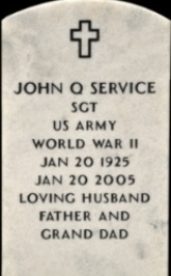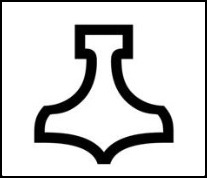The Avengers Burial Ground

Iron Man, the movie, hit screens in 2008, the first of many films in the Marvel Cinematic Universe. Iron Man has been joined by other heroes since — Captain America, Ant-Man, Doctor Strange, Black Panther, and for our purposes today, Thor. The Avengers franchise has captured the imagination of a generation, and its popularity has rivaled sci-fi/fantasy franchises such as Star Trek, Star Wars, and the like.
Which is why, 2013, a quiet decision by the United States Department of Veterans Affairs (VA) was so buzzworthy. Starting that year, if you served in the U.S. military, you could be buried under an image of the below — Mjölnir, the hammer of Thor.

If you visit an American military cemetery, you’ll see rows of gravestones marking the final resting place of American veterans. Each of these gravestones follows a simple pattern, one reflected by the image below (via the VA’s website). On the gravemarker is deceased’s name, rank, the branch of service, wars in which he or she served, and date of birth and death, and perhaps some other information provided by the next of kin. And at the top is a symbol marking the deceased’s religion.

But you aren’t limited to a cross, Star of David, Islamic star and crescent, or other symbols commonly associated with mainstream religions — at least not anymore.
In 2005, Sergeant Patrick Stewart (no relation to the Star Trek and X-Men guy of the same name) died when his helicopter was shot down in Afghanistan. Stewart’s widow, Roberta, wished that he be buried in a veteran’s cemetery — that part wasn’t a problem — and with a headstone representing their religion. But the Stewarts were Wiccan and the Department of Veterans Affairs (VA) did not list a Wiccan Pentacle on its list of approved headstone symbols. Ms. Stewart sued, with the backing of a number of organizations, and the VA settled the case in 2007. As part of the settlement, the Pentacle, seen here, is now on the list of approved symbols.
The VA, seeing the writing on the wall, quietly added more and more religious symbols into that approved list over the subsequent years. And in 2013, Mjölnir appeared on the list for the first time. And no, this isn’t some sort of cult of Stan Lee. Yes, Mjölnir plays a central role in Marvel comics and in the Marvel Cinematic Universe; made from metal forged in the heart of a dying star, it conveys extraordinary power to anyone worthy of wielding it. But it’s based on Old Norse myths, some of which form the basis of a sect of paganism called Heathenry or Odinism. Followers of this religion have adopted Mjölnir as their own, and can now use Thor’s Hammer on their gravestones.
According to Fast Company, there are at least two people buried under the emblem of Mjölnir: a marine Sergeant identified only as Shane and his late father, whose previously blank gravestone was retroactively updated. But there’s little other information about it and, no, there aren’t any pictures, either.
Bonus fact: Thor isn’t the only sci-fi character associated with a VA-approved gravestone symbol. Spock, the half-Vulcan star of Star Trek, is as well. The Vulcan greeting “live long, and prosper” has a corresponding hand symbol, seen here. That hand sign is inspired by a gesture used by Jewish priests (called “Kohanim”) when they convey their priestly blessing — the main difference is that the Vulcans use only one hand while the Kohanim use two. If you want, you can have “Kohen Hands,” seen here, engraved on your VA gravestone.
From the Archives: Until Death Do Us Reunite: The Romeo and Juliet of gravestones.
